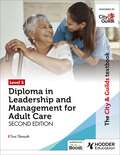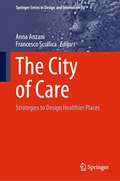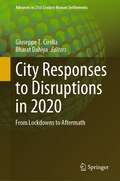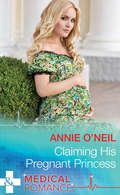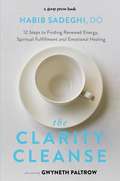- Table View
- List View
The City & Guilds Textbook Level 5 Diploma in Leadership and Management for Adult Care: Second Edition
by Tina TilmouthDevelop best practice and improve your leadership skills with our second edition textbook (for the 3096-51 specification).- Develop a comprehensive understanding of the knowledge and skills required with detailed coverage of all mandatory units- Apply theoretical aspects of the Diploma in the workplace, and use our 'Evidence Opportunity' feature to test your understanding of the assessment criteria- Build confidence reviewing and evaluating practice in Adult Care settings with 'Reflect On It' activities, and examples of reflective accounts- Prepare a strong portfolio, with advice and activities on how to use evidence most effectively This textbook has been fully updated to meet the requirements of the updated Skills for Care qualification criteria.
The City in Need: Urban Resilience and City Management in Disruptive Disease Outbreak Events
by Ali CheshmehzangiThis book fills a major gap in academic research, by exploring ‘urban resilience measures’ and ‘city management issues’ during disruptive disease outbreak events. Based on the overarching concept of ‘resilience thinking’, it addresses critical issues of preparedness, responsiveness and reflectiveness in the event of outbreak, focusing on cities and how they should prepare to combat a variety of adversities and uncertainties caused by outbreaks. This comprehensive book is an essential guide for decision-makers, city authorities, planners, healthcare and public health authorities, and those communities and businesses that face disease outbreak events. It also offers a set of practical measures to support the development of tailor-made strategies in the form of an action plan. These strategies should address outbreak control and containment measures, institutional rearrangements, management of urban systems, and healthiness of the society. Divided into six chapters, this book explores important topics of ‘urban resilience’ and ‘city management’ for preparedness action plans and responsiveness planning. Further, it presents a comprehensive urban resilience approach used to support city management in the recent outbreaks in Chinese cities, which can be applied in cities around the globe to strengthen their resilience and maximise the practicality of urban resilience and minimise urban vulnerabilities during disease outbreaks. Highlighting topics such as maintaining societal well-being, community engagement, and multi-sectoral city management enhancement, this book offers a unique combination of research, practices and lessons learned to aid cities in need.
The City of Care: Strategies to Design Healthier Places (Springer Series in Design and Innovation #26)
by Anna Anzani Francesco ScullicaThe book explores care as a transition strategy to a healthier and more sustainable world. After the lesson learned from the pandemic, health as a fundamental human right is increasingly related to a care component: caring for sick people, persons with disabilities, elders, migrants and refugees, women and children, caring for bodies, minds, cities and nature. Endorsing the care system as a female knowledge based on complexity, flexibility, management of the unexpected, sense of responsibility, the project culture can extract this paradigm from the domestic perimeter, bring outside and make it accessible to all in work, politics, relationships, places and communities. The systemic connection between planet and people wellbeing will be grasped through a transdisciplinary perspective that allows to deal with the city of care at a mental, physical, social and global level. The first section addresses care and interior space, dealing with dwelling, working, proximity and cities on a human scale, with a particular attention to the post Covid conditions. The second section deals with healthcare design, the evolution and trend of healing spaces, the influence of technology and robotics on inclusive design processes. The third section considers a social care attitude and deals with the multiethnic urban dimension, care and creativity in design, society and relationships, the right to health of immigrant people.
City of Omens: A Search for the Missing Women of the Borderlands
by Dan WerbFor decades, American hungers sustained Tijuana. In this scientific detective story, a public health expert reveals what happens when a border city's lifeline is brutally severed.Despite its reputation as a carnival of vice, Tijuana was, until recently, no more or less violent than neighboring San Diego, its sister city across the border wall. But then something changed. Over the past ten years, Mexico's third-largest city became one of the world's most dangerous. Tijuana's murder rate skyrocketed and produced a staggering number of female victims. Hundreds of women are now found dead in the city each year, or bound and mutilated along the highway that lines the Baja coast.When Dan Werb began to study these murders in 2013, rather than viewing them in isolation, he discovered that they could only be understood as one symptom among many. Environmental toxins, drug overdoses, HIV transmission: all were killing women at overwhelming rates. As an epidemiologist, trained to track epidemics by mining data, Werb sensed the presence of a deeper contagion targeting Tijuana's women. Not a virus, but some awful wrong buried in the city's social order, cutting down its most vulnerable inhabitants from multiple directions.Werb's search for the ultimate causes of Tijuana's femicide casts new light on immigration, human trafficking, addiction, and the true cost of American empire-building. It leads Werb all the way from factory slums to drug dens to the corridors of police corruption, as he follows a thread that ultimately leads to a surprising turn back over the border, looking northward.“City of Omens is a compelling and disturbing tour of a border world that outsiders rarely see - and simultaneously, a clear guide to a field of public health that offers an essential framework for understanding how both ideas and diseases can spread.” -- MAIA SZALAVITZ, author of Unbroken Brain“Dan Werb combines his expertise as a trained epidemiologist with his keen discernment as an investigative journalist to depict what happens when poverty, human desperation, and unfathomable greed at the highest levels of a society mix with imperial ambition and a criminally ill-conceived policy towards drug use. It is a riveting and heartbreaking story, told with eloquence and compassion.” -- GABOR MATÉ, MD, bestselling author of In the Realm of Hungry Ghosts: Close Encounters with Addiction“City of Omens is an urgent and needed account of a desperate problem. The perils that Mexico's women face haunt the conscience of a nation.” -- ALFREDO CORCHADO, author of Homelands and Midnight in Mexico
City Responses to Disruptions in 2020: From Lockdowns to Aftermath (Advances in 21st Century Human Settlements)
by Giuseppe T. Cirella Bharat DahiyaThis book presents the integrating of economics and urban geography to create a framework of cooperation around the idea of urban economic stability. It explores these disciplines through the economic lens and creates a collaborative environment for addressing the global challenges caused by the COVID-19 pandemic and future global shocks. Environmental advocates and proponents of economic growth are increasingly at odds—having looked at the economic impact of the decline of the environment as well as the environmental loss that occurs with unchecked growth and urbanization. The outbreak of the COVID-19 pandemic changed the global scene. The world shook in its foundations, as a number of countries’ lockdown affected not only the global economy but also society and the environment. The global community has seen the negative impact of COVID-19 on our economies. There have been steep declines in gross domestic product, job losses have been in the millions, and people have seen their incomes fall. An unplanned shutdown has taken its toll and has been a shock to the economies of the world. Past shocks and how they have impacted urban economies as well as for how long are core to bettering our understanding of present and future urban economic change. The underlying economic factors that make a shock more damaging to certain economies or industries, as well as understanding these vulnerabilities, help entities recover from economic shocks and allow them to better understand how impacts on individual businesses can be implemented. The pandemic revealed the need to adopt a global development approach, taking into consideration four dimensions: global value chains, debt, digitalization, and the environment. Topics related to the causation and lockdown are explored through a number of case studies from around the world.
City Surgeon, Small Town Miracle (Mills And Boon Medical Ser.)
by Marion LennoxDr Maggie Croft's decision to have her late husband's baby has left her combining pregnancy with caring for a small town community! Dr Max Ashton had been heading back to his glamorous city life – but Maggie makes him remember another time, before he locked his heart away…
Civic Engagement and the Baby Boomer Generation: Research, Policy, and Practice Perspectives
by Laura WilsonDiscover a vital source of volunteers for your organizationBy the year 2020, there will be 65 million people aged 65 and over living in the United States-a new generation of active older adults expecting to use the expertise, experience, and life skills they&’ve gained to make valuable contributions to society in their retirement years. Civic Engagement and the Baby Boomer Generation presents the latest research findings and evaluation studies that help promote a thorough understanding of the programs, policies, and civic opportunities available to people aged 50 and older. This unique book is an essential resource for nonprofit organizations seeking to meet their needs with a generation of volunteers eager to explore new options, work in new capacities, and continue lifelong learning.More than any previous generation, baby boomers (born between 1946 and 1964) are defying stereotypes about aging while seeking new and meaningful lifestyles. Civic Engagement and the Baby Boomer Generation defines an agenda for future policy, research, and practice to help reverse the well-documented decline in civic engagement in the United States, providing older Americans with opportunities to have an impact in their local, national, and global communities. The book&’s contributors focus attention on the value of civic engagement in creating vital social capital and social networks. Civic Engagement and the Baby Boomer Generation examines: current issues and trends in civic engagement results from senior corps. examinations expanding youth service concepts lifelong learning institutes the relationship between civic engagement and leadership issues in elder service and volunteerism outcomes of a national agenda setting meeting intergenerational relations and civic engagement Civic Engagement and the Baby Boomer Generation is an important source of information for anyone working with nonprofit, government, and corporate organizations concerned with public policy, community affairs, volunteerism, research, practice, and education.
Civic Engagement and the Baby Boomer Generation: Research, Policy, and Practice Perspectives
by Laura WilsonDiscover a vital source of volunteers for your organizationBy the year 2020, there will be 65 million people aged 65 and over living in the United States-a new generation of active older adults expecting to use the expertise, experience, and life skills they&’ve gained to make valuable contributions to society in their retirement years. Civic Engagement and the Baby Boomer Generation presents the latest research findings and evaluation studies that help promote a thorough understanding of the programs, policies, and civic opportunities available to people aged 50 and older. This unique book is an essential resource for nonprofit organizations seeking to meet their needs with a generation of volunteers eager to explore new options, work in new capacities, and continue lifelong learning.More than any previous generation, baby boomers (born between 1946 and 1964) are defying stereotypes about aging while seeking new and meaningful lifestyles. Civic Engagement and the Baby Boomer Generation defines an agenda for future policy, research, and practice to help reverse the well-documented decline in civic engagement in the United States, providing older Americans with opportunities to have an impact in their local, national, and global communities. The book&’s contributors focus attention on the value of civic engagement in creating vital social capital and social networks. Civic Engagement and the Baby Boomer Generation examines: current issues and trends in civic engagement results from senior corps. examinations expanding youth service concepts lifelong learning institutes the relationship between civic engagement and leadership issues in elder service and volunteerism outcomes of a national agenda setting meeting intergenerational relations and civic engagement Civic Engagement and the Baby Boomer Generation is an important source of information for anyone working with nonprofit, government, and corporate organizations concerned with public policy, community affairs, volunteerism, research, practice, and education.
Civil Commitment in the Treatment of Eating Disorders: Practical and Ethical Considerations
by Wayne BowersCivil Commitment in the Treatment of Eating Disorders presents a comprehensive view on the use of involuntary hospitalization in the treatment of patients with anorexia and other eating disorders. This volume synthesizes the existing empirical data and ethical perspectives surrounding this sometimes controversial approach to treatment in order to establish a balanced, compassionate understanding of current research and patient experiences. Particular attention is paid to the use and misuse of persuasion and coercion in civil commitment and to when these concepts are applicable. This accessible new volume prepares treatment providers to understand the role of civil commitment in their treatment practices and in patients’ recovery.
Civil Commitment in the Treatment of Eating Disorders: Practical and Ethical Considerations
by Wayne BowersCivil Commitment in the Treatment of Eating Disorders presents a comprehensive view on the use of involuntary hospitalization in the treatment of patients with anorexia and other eating disorders. This volume synthesizes the existing empirical data and ethical perspectives surrounding this sometimes controversial approach to treatment in order to establish a balanced, compassionate understanding of current research and patient experiences. Particular attention is paid to the use and misuse of persuasion and coercion in civil commitment and to when these concepts are applicable. This accessible new volume prepares treatment providers to understand the role of civil commitment in their treatment practices and in patients’ recovery.
Civil Engineering: Supervision And Management
by A.C. Twort J.G. ReesThis book covers methods adopted for undertaking the design and construction of civil engineering projects. The options for separate design and construction are compared with design and build projects, construction management, and man agement contracting. The salient differences are shown between the various con ditions of contract used. The roles of the engineer, employer's project manager or his representative under different forms of contract are compared. Requirements for the production of contract documents, specifications, tendering procedures and choice of contractor are set out. The engineer's powers and the duties of his resident engineer on the site of con struction are considered in detail. Records, filing systems, programme and progress charts used by the resident engineer are illustrated, and advice is given on the handling of safety problems and difficult situations on site. Problems of measurement and billing of quantities according to the civil engi neering standard method are described. Correct procedures for setting rates for varied work, payment for method-related items, and handling claims for unfore seen conditions under ICE Clause 12 are given. Difficulties with delay claims and situations where the contractor submits quotations before undertaking varied work are discussed. The approach is essentially practical throughout and covers many actual prob lems met on site, including measures that are advisable in relation to site surveys and investigations, construction of earthworks and pipelines, and the production and placing of concrete.
Civil Procedure in Czech Republic
by Alena MackováDerived from the renowned multi-volume International Encyclopaedia of Laws, this convenient volume provides comprehensive analysis of the legislation and rules that determine civil procedure and practice in Czech Republic. Lawyers who handle transnational matters will appreciate the book’s clear explanation of distinct terminology and application of rules. The structure follows the classical chapters of a handbook on civil procedure: beginning with the judicial organization of the courts, jurisdiction issues, a discussion of the various actions and claims, and then moving to a review of the proceedings as such. These general chapters are followed by a discussion of the incidents during proceedings, the legal aid and legal costs, and the regulation of evidence. There are chapters on seizure for security and enforcement of judgments, and a final section on alternative dispute resolution. Facts are presented in such a way that readers who are unfamiliar with specific terms and concepts in varying contexts will fully grasp their meaning and significance. Succinct, scholarly, and practical, this book will prove a valuable time-saving tool for business and legal professionals alike. Lawyers representing parties with interests in Czech Republic will welcome this very useful guide, and academics and researchers will appreciate its comparative value as a contribution to the study of civil procedure in the international context.
Civil Procedure in Czech Republic
by Alena MackováDerived from the renowned multi-volume International Encyclopaedia of Laws, this convenient volume provides comprehensive analysis of the legislation and rules that determine civil procedure and practice in Czech Republic. Lawyers who handle transnational matters will appreciate the book’s clear explanation of distinct terminology and application of rules. The structure follows the classical chapters of a handbook on civil procedure: beginning with the judicial organization of the courts, jurisdiction issues, a discussion of the various actions and claims, and then moving to a review of the proceedings as such. These general chapters are followed by a discussion of the incidents during proceedings, the legal aid and legal costs, and the regulation of evidence. There are chapters on seizure for security and enforcement of judgments, and a final section on alternative dispute resolution. Facts are presented in such a way that readers who are unfamiliar with specific terms and concepts in varying contexts will fully grasp their meaning and significance. Succinct, scholarly, and practical, this book will prove a valuable time-saving tool for business and legal professionals alike. Lawyers representing parties with interests in Czech Republic will welcome this very useful guide, and academics and researchers will appreciate its comparative value as a contribution to the study of civil procedure in the international context.
Civil Structural Health Monitoring: Proceedings of CSHM-9 Workshop (Lecture Notes in Civil Engineering #516)
by Waleed Abdullah Muhammad Tariq Chaudhary Hasan Kamal Jafarali Parol Abdullah AlmutairiThis book gathers the latest advances and innovations in the field of structural health monitoring, as presented at the 9th Civil Structural Health Monitoring Workshop (CSHM-9), held in Kuwait on February 12–14, 2024. It discusses emerging challenges in civil SHM and more broadly in the fields of smart materials and intelligent systems for civil engineering applications. The contributions cover a diverse range of topics, including applications of SHM to civil structures and infrastructures, innovative sensing solutions for SHM, data-driven damage detection techniques, nonlinear systems and analysis techniques, influence of environmental and operational conditions, aging structures and infrastructures in hazardous environments, and SHM in earthquake prone regions. Selected by means of a rigorous peer-review process, they will spur novel research directions and foster future multidisciplinary collaborations.
Civil Structural Health Monitoring: Proceedings of CSHM-8 Workshop (Lecture Notes in Civil Engineering #156)
by Carlo Rainieri Giovanni Fabbrocino Nicola Caterino Francesca Ceroni Matilde A. NotarangeloThis volume gathers the latest advances and innovations in the field of structural health monitoring, as presented at the 8th Civil Structural Health Monitoring Workshop (CSHM-8), held on March 31–April 2, 2021. It discusses emerging challenges in civil SHM and more broadly in the fields of smart materials and intelligent systems for civil engineering applications. The contributions cover a diverse range of topics, including applications of SHM to civil structures and infrastructures, innovative sensing solutions for SHM, data-driven damage detection techniques, nonlinear systems and analysis techniques, influence of environmental and operational conditions, aging structures and infrastructures in hazardous environments, and SHM in earthquake prone regions. Selected by means of a rigorous peer-review process, they will spur novel research directions and foster future multidisciplinary collaborations.
Civilian Lunatic Asylums During the First World War: A Study of Austerity on London's Fringe (Mental Health in Historical Perspective)
by Claire HiltonThis open access book explores the history of asylums and their civilian patients during the First World War, focusing on the effects of wartime austerity and deprivation on the provision of care. While a substantial body of literature on ‘shell shock’ exists, this study uncovers the mental wellbeing of civilians during the war. It provides the first comprehensive account of wartime asylums in London, challenging the commonly held view that changes in psychiatric care for civilians post-war were linked mainly to soldiers’ experiences and treatment. Drawing extensively on archival and published sources, this book examines the impact of medical, scientific, political, cultural and social change on civilian asylums. It compares four asylums in London, each distinct in terms of their priorities and the diversity of their patients. Revealing the histories of the 100,000 civilian patients who were institutionalised during the First World War, this book offers new insights into decision-making and prioritisation of healthcare in times of austerity, and the myriad factors which inform this.
Civilization and Disease (Messenger Lectures)
by Henry E. SigeristOriginally published in 1943, Civilization and Disease was based on a series of lectures that the medical historian Henry E. Sigerist delivered at Cornell University in 1940. Now back in print, the book is a wide-ranging account of the importance of social factors on health and illness and the impact that disease has had on societies throughout human history. Despite considerable advances in both medicine and historiography, Civilization and Disease remains a landmark work in the history of medicine and a fascinating look at, first, civilization as a factor in the genesis and spread of disease, and second, the effects of disease on such aspects of civilization as economics, social life, law, philosophy, religion, science, and the arts. In a new foreword written for this edition, Elizabeth Fee outlines Sigerist’s life, works, and legacy as a historian, a teacher, and an advocate for universal health care, hailing Civilization and Disease as "an excellent introduction to Sigerist’s work."
The Clarity Cleanse: 12 Steps to Finding Renewed Energy, Spiritual Fulfilment and Emotional Healing
by Dr Habib SadeghiA GOOP insider and advisor to Gwyneth Paltrow, Emily Blunt, Tim Robbins, Stella McCartney and others, Dr Sadeghi shows you how to turn obstacles into healing and energising opportunities.Based on the powerful mind-body strategy Dr Habib Sadeghi developed to help himself recover from cancer more than twenty years ago, THE CLARITY CLEANSE will enable you to clear your mind and heal your body. The Clarity Cleanse has two components: DIETARY and EMOTIONAL. The diet is designed to negate the physical residue of repressed emotions in the organs most affected by negativity. By following this diet for 10 days a month while alternating between emotional purging exercises - 12-minute writings and 12-minute dialogues - readers will find emotional clarity, clarity of vision and clarity of action in their daily lives.With THE CLARITY CLEANSE you learn how to:· Create clear intention· Purge negative emotions· Practice compassionate self-forgiveness· Refocus negative energy to move beyond doubt and fear· Ask the kind of questions that will help your relationshipsBy following the twelve steps in this book, you will achieve a sense of peace and control, raise your self-esteem, and assert yourself in new ways to achieve positive and lasting change. Then, finally, you will be able to express your true, authentic self.
Clark's Essential Guide to Clinical Ultrasound (Clark's Companion Essential Guides)
by Jan Dodgeon Gill HarrisonThis easy-to-understand pocketbook in the highly respected Clark’s stable of diagnostic imaging texts is an invaluable tool for students, sonographers and other ultrasound practitioners, providing practical guidance on clinical ultrasound procedures, summarising current relevant literature and professional body guidelines. The content is arranged by anatomical system and organ for ease of reference, with each section comprising a short introduction, the indications for the procedure, patient preparation, the imaging procedure itself, along with an image analysis, supported throughout by positioning photographs and clinical images. Clark’s Essential Guide to Clinical Ultrasound is ideal for all users of clinical ultrasound at both undergraduate and postgraduate level and will also provide a convenient distillation of the latest best practice and guidelines for sonographers, midwives, vascular technologists, ECG technologists, medical doctors, sports injury specialists, paramedics, and other health professionals.
Clark's Essential Guide to Clinical Ultrasound (Clark's Companion Essential Guides)
by Jan Dodgeon Gill HarrisonThis easy-to-understand pocketbook in the highly respected Clark’s stable of diagnostic imaging texts is an invaluable tool for students, sonographers and other ultrasound practitioners, providing practical guidance on clinical ultrasound procedures, summarising current relevant literature and professional body guidelines. The content is arranged by anatomical system and organ for ease of reference, with each section comprising a short introduction, the indications for the procedure, patient preparation, the imaging procedure itself, along with an image analysis, supported throughout by positioning photographs and clinical images. Clark’s Essential Guide to Clinical Ultrasound is ideal for all users of clinical ultrasound at both undergraduate and postgraduate level and will also provide a convenient distillation of the latest best practice and guidelines for sonographers, midwives, vascular technologists, ECG technologists, medical doctors, sports injury specialists, paramedics, and other health professionals.
Clark's Essential Guide to Mammography (Clark's Companion Essential Guides)
by Claire Borrelli Claire MercerThis easy-to-understand pocketbook in the highly respected Clark’s stable of imaging texts is an invaluable tool and training aid, providing essential information for mammographic positioning, technique and interpretation for mammography practitioners at all levels. Adopting a systematic and structured approach facilitating rapid reference in the clinical setting, the book covers general principles and all routine mammographic projections, including additional and adapted projections covered in a separate section, and is highly illustrated with clear explanatory line diagrams and imaging photographs. Clark’s Essential Guide to Mammography is ideal as an educational tool for trainee mammographers, trainee assistant and associate apprenticeship mammographers, mammography training teams and universities delivering mammography education and a convenient clinical guide for practising mammographers, including assistant and associate apprenticeship mammographers.
Clark's Essential Guide to Mammography (Clark's Companion Essential Guides)
by Claire Borrelli Claire MercerThis easy-to-understand pocketbook in the highly respected Clark’s stable of imaging texts is an invaluable tool and training aid, providing essential information for mammographic positioning, technique and interpretation for mammography practitioners at all levels. Adopting a systematic and structured approach facilitating rapid reference in the clinical setting, the book covers general principles and all routine mammographic projections, including additional and adapted projections covered in a separate section, and is highly illustrated with clear explanatory line diagrams and imaging photographs. Clark’s Essential Guide to Mammography is ideal as an educational tool for trainee mammographers, trainee assistant and associate apprenticeship mammographers, mammography training teams and universities delivering mammography education and a convenient clinical guide for practising mammographers, including assistant and associate apprenticeship mammographers.
Clark’s Essential Guide to Mobile and Theatre Imaging (Clark's Companion Essential Guides)
by Helen Fowler Ken Holmes Amanda Martin Andrea HulmeThis easy-to-understand pocketbook in the highly respected Clark’s stable of diagnostic imaging texts is an invaluable tool for student and practising radiographers, providing practical guidance to undertaking a wide range of mobile and theatre imaging examinations in multiple locations − different theatre environments, the Emergency Department, Intensive Care Units, including Neonatal Intensive Care Units, and on general wards.Carrying out examinations outside the imaging suite can be particularly challenging, given the circumstances in which they are often requested, the condition of the patient and the complexity of the environment. Additionally, management of the team and area from a radiation protection point of view is the responsibility of the radiographer and requires excellent communication skills.Clark’s Essential Guide to Mobile and Theatre Imaging takes the systematic approach adopted within books in the Clark's family and is designed to be clear and consistent, in which each imaging location is explored, the challenges of each identified and possible solutions presented. A wide range of theatre procedures is included, as well as the imaging requirements of each, and common theatre practices, such as time out, are considered.
Clark’s Essential Guide to Mobile and Theatre Imaging (Clark's Companion Essential Guides)
by Helen Fowler Ken Holmes Amanda Martin Andrea HulmeThis easy-to-understand pocketbook in the highly respected Clark’s stable of diagnostic imaging texts is an invaluable tool for student and practising radiographers, providing practical guidance to undertaking a wide range of mobile and theatre imaging examinations in multiple locations − different theatre environments, the Emergency Department, Intensive Care Units, including Neonatal Intensive Care Units, and on general wards.Carrying out examinations outside the imaging suite can be particularly challenging, given the circumstances in which they are often requested, the condition of the patient and the complexity of the environment. Additionally, management of the team and area from a radiation protection point of view is the responsibility of the radiographer and requires excellent communication skills.Clark’s Essential Guide to Mobile and Theatre Imaging takes the systematic approach adopted within books in the Clark's family and is designed to be clear and consistent, in which each imaging location is explored, the challenges of each identified and possible solutions presented. A wide range of theatre procedures is included, as well as the imaging requirements of each, and common theatre practices, such as time out, are considered.
